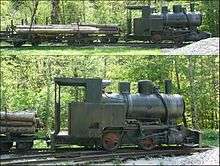Tramway (industrial)
Tramways are lightly laid railways, sometimes with the wagons or carriages moved without locomotives. Because individual tramway vehicles are not intended to carry the weight of typical standard-gauge railway equipment, the tramways over which they operate may be built from less substantial materials. Tramways can take many forms; sometimes just tracks temporarily placed on the ground to transport materials around a factory, mine or quarry. Many, if not most, use narrow-gauge railway technology. The trains can be manually pushed by hand, pulled by animals (especially horses and mules), cable hauled by a stationary engine, or use small, light locomotives. At the other extreme they could be complex and lengthy systems, such as the Lee Moor Tramway in the county of Devon, England, in the United Kingdom.

The term is not in use in North America but in common use in the United Kingdom, and elsewhere, where British Railway terminology and practices had large influences on management practices, terminology, and railway cultures such as Australia, New Zealand, and those parts of Asia that consulted with British experts when undergoing modernization. In New Zealand, they are commonly known as bush tramways, while in parts of Australia where American experts were influential, the term is less common. They generally do not carry passengers, although staff may use them, either officially or unofficially—and are often not intended to be permanent.
History
The term was originally applied to wagons running on primitive tracks in early England and Europe. The name seems to date from around 1517 and to be derived from an English dialect word for the shaft of a wheelbarrow—in turn from Low German traam, literally, beam.[1]
The tracks themselves were sometimes known as gangways,[2] dating from before the 12th century, being usually simply planks laid upon the ground[1] literally "going road".[3] In south Wales and Somerset the term "dramway" is also used, with vehicles being called drams.
The alternative term is "wagonway" (and wainway or waggonway) which originally consisted of horses, equipment and tracks which were used for hauling wagons.
Usually the wheels would be guided along grooves. In time, to combat wear, the timber would be reinforced with an iron strip covering. This developed to use "L"-shaped steel plates, the track then being known as a plateway.
The origin of the word railway is uncertain, but Benjamin Outram was referring to his lines as railways in the early 19th century. The fact that many of these lines were built for horse-drawn vehicles, and were dimensioned accordingly, is thought to be behind the modern 4 ft 8 1⁄2 in (1,435 mm) standard gauge.
An alternative appeared, the so-called "edge-rail" where the wagons were guided by having the wheels flanged instead of running in grooves. Since these rails were raised above the ground they were less likely to be blocked by debris, but they obstructed other traffic. They were, however, the forerunners of the modern railway.
These early lines were built to transport minerals from quarries and mines to canal wharves. From about 1830, more extensive trunk railways appeared, becoming faster, heavier and more sophisticated and, for safety reasons, the requirements placed on them by Parliament became more and more stringent. See rail tracks.
These restrictions were excessive for the small mineral lines and it became possible in the United Kingdom for them to be categorised as Light railways subject to certain provisos laid down by the Light Railways Act 1896.
Meanwhile, in the United Kingdom the term tramway became the term for passenger vehicles (a tram) that ran on tracks in the public highway, sharing with other road users.[4] Initially horse-drawn, they developed to use electric power from an overhead line. A development of the tramway in the United Kingdom dispensed with tracks, but retained electric power from overhead wires; it was the trolley bus.
In 2000 the CarGoTram began operating as a cargo tram for the Volkswagen factory in Dresden.
Notional tramways
In Australia, most "tramways" (other than urban street trams) were in practice heavy railways, or equivalent to British light railways, but known as tramways for legal reasons. These include:
- Kerang–Koondrook Tramway, a 5 ft 3 in (1,600 mm) gauge private railway which junctioned with the Victorian Railways at Kerang.
- Yass Tramway, a standard gauge branch line operated by the New South Wales Government Railways.
- Silverton Tramway in New South Wales which junctioned end on with the South Australian Railways.
- Iron Knob Tramway in South Australia.
- 15 lines in Queensland operated by local councils under the Tramways Act of 1882, such as the Belmont Tramway and Beaudesert Shire Tramway.
- 28 (now 20, incorporating 27 of the original 28) sugar cane railways in Queensland, each operated by a sugar cane mill.[5]
- Pemberton Tramway, a tourist railway in Western Australia.
See also
| Wikimedia Commons has media related to Tramways (industrial). |
References
- Merriam-Webster's Collegiate Dictionary (On line accessed 27 Oct 2007)
- As, for instance Little Eaton Gangway
- Hoad, T. F. (1966). Concise Oxford Dictionary of English Etymology. Oxford University Press.
- 1901: Standing Orders, House of Lords, Priv. bills 7 "In these orders ... 'Tramway' means a tramway laid along a street or road; the term 'tramroad' means a tramway laid elsewhere than along a street or road." From Oxford English Dictionary On-line (Second Ed 1989)
- "Queensland sugar cane railways today". Light Rail Research Society of Australia Inc. Retrieved 12 June 2017.
.jpg)